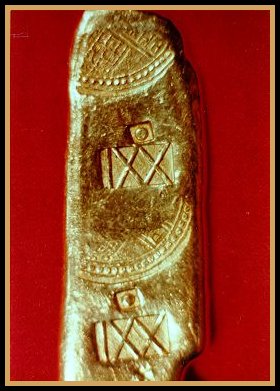DETAIL--FIRST EN RADA BAR,
UPPER THIRD. 
Not indicated by any of its
markings are
its dimensions (approx. 6.2” long X 1.1” wide X 0.3” thick) and its
weight,
which is recorded as one pound, five ounces (Mathewson). I assume this
to be U. S. weight in consideration of the approximate volume of the
bar.
So, it must weigh 21 ounces (U. S.) X 1.215 (conversion factor) = 25.5
troy ounces. At a [1988] market price of $450 per ounce, the
bar’s
“melt” value would be $11,475. Because of its fineness as an artifact,
and because there are so few of these in existence, I would assign it a
historical multiplier of 5X to 10X (see PLVS VLTRA Newsletter,
1st Quarter, 1988), which means that it would have a “historic value”
of
between $57,375 and $114, 750!
THE “MYSTERY” MARK
Boldly impressed on top of
one of the “royal
stamps” is a curious cartouche containing what appears to be six block
letters. At first glance, the letters seem to spell EN RADA
in Spanish, hence the nickname for this ingot of gold: “the EN RADA
bar.” Because the lettering was conspicuously different from what had
been
seen on other bars found up to that time, the moniker stuck.
Eugene Lyon briefly mentioned
in
his book that La Rada was the area of an inner harbor at
Cartagena (Colombia). In Spanish, that would be interpreted as “the
anchorage”—too
generic a term to be a pronouncement on a gold bar. Closer examination
of the marking reveals that EN RADA is actually a Spanish
monogram
containing at least nine different letters. Then they must
spell something more than EN RADA! Last year [1987], Dr. Lyon
and
I discussed the cartouche in light of its being a monogram, and we
postulated
that it could stand for NUEVA GRANADA, possibly indicating the mint or
mine in Colombia at which the bar was produced. I later had to discount
this possibility for the lack of a “G” in the design.
 |
PREVIOUS
<< PAGE |
|
|
TURN THE
PAGE >> |
 |
|